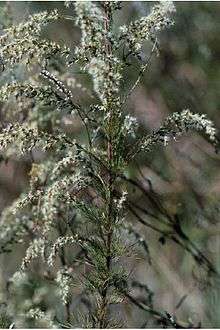Eupatorium capillifolium
| Eupatorium capillifolium | |
|---|---|
 | |
| Scientific classification | |
| Kingdom: | Plantae |
| (unranked): | Angiosperms |
| (unranked): | Eudicots |
| (unranked): | Asterids |
| Order: | Asterales |
| Family: | Asteraceae |
| Genus: | Eupatorium |
| Species: | E. capillifolium |
| Binomial name | |
| Eupatorium capillifolium (Lam.) Small | |
| Synonyms[2] | |
|
Synonymy
| |
Eupatorium capillifolium (dogfennel) is a North American perennial herbaceous plant in the family sunflower family, native to the eastern and south-central United States.[3] It is generally between 50 cm and 2 meters tall with several stems that fork from a substantial base.[4] The stems and base are covered in leaves so dissected that they resemble branching green threads coming out of the stem in fractal patterns. When crushed, the leaves and flowers smell rather unpleasant.[4]
Classification
Dogfennel is closely related to Eupatorium compositifolium (yankeeweed) and Eupatorium leptophyllum and some authors consider all of them varieties of E. capillifolium.[5] Others maintain them as three species but consider them a related group, known as dogfennels or the Traganthes group. They all are characterized by dissected leaves.[6][7]
Cultivation and uses
Dogfennel thrives on roadsides,[5] in fields and reduced tillage crops, as well as areas that have burned or otherwise been disturbed.[5] It is found in the early to middle (seral) stages of ecological succession. It is native to the southern and eastern United States, from Massachusetts south to Florida, and west to Missouri and Texas,[8][9] and also Cuba and the Bahamas.[10] Unlike insect-pollinated plants in this genus, E. capillifolium is wind-pollinated.[10]
Dogfennel is eaten by Florida's scarlet-bodied wasp moth, Cosmosoma myrodora. These moths feed on the plant while mature, to store its toxins and ward off predators.
Control
Dogfennel spreads by both seeds and rootstocks and can grow quite aggressively. It is common in pastures, especially those that are unimproved or overgrazed,[5] and degrades the quality of the pasture by competing with desired forage species.[11] Dogfennel contains liver-damaging pyrrolizidine alkaloids, so livestock are known to eat all the turf around a stand of it. To remove infestations of dogfennel, the recommended course of action is to mow it and apply herbicides.[11]
It has also been introduced outside its native range, for example in Nepal.[12]
References
- ↑ "Eupatorium capillifolium". NatureServe Explorer. NatureServe. Retrieved 2010-09-12.
- ↑ The Plant List, Eupatorium capillifolium (Lam.) Small ex Porter & Britton
- ↑ "Eupatorium capillifolium (Lam.) Small". PLANTS.
- 1 2 Uva, Richard H; Joseph C. Neal; Joseph M. Ditomaso (1997). Weeds of The Northeast. Ithaca, NY: Cornell University Press. pp. 140–141. ISBN 0-8014-8334-4.
- 1 2 3 4 "Eupatorium capillifolium". Fire Effects Information System. U.S. Department of Agriculture, Forest Service, Rocky Mountain Research Station, Fire Sciences Laboratory. Retrieved 2008-08-06.
- ↑ Kunsiri Chaw Siripun and Edward E. Schilling (2006). "Molecular confirmation of the hybrid origin of Eupatorium godfreyanum (Asteraceae)". American Journal of Botany. 93 (2): 319–325. doi:10.3732/ajb.93.2.319. PMID 21646192.
- ↑ Gregory J. Schmidt and Edward E. Schilling (2000). "Phylogeny and biogeography of Eupatorium (Asteraceae: Eupatorieae) based on nuclear ITS sequence data". American Journal of Botany. 87 (5): 716–726. doi:10.2307/2656858. JSTOR 2656858. PMID 10811796.
- ↑ "Eupatorium capillifolium". Flora of North America.
- ↑ Biota of North America Program 2014 county distribution map
- 1 2 Victoria I. Sullivan, Joseph Neigel and Bomao Miao (May 1991). "Bias in Inheritance of Chloroplast DNA and Mechanisms of Hybridization between Wind- And Insect-Pollinated Eupatorium (Asteraceae)". American Journal of Botany. 78 (5): 695–705. doi:10.2307/2445090. JSTOR 2445090.
- 1 2 Ferrell, J.A.; G.E. MacDonald. "Dogfennel (Eupatorium capillifolium): Biology and Control". University of Florida. Retrieved 2007-02-04.
- ↑ Annotated Checklist of the Flowering Plants of Nepal, Eupatorium capillifolium
